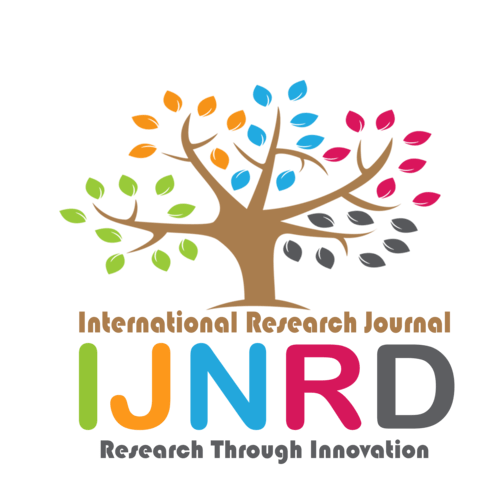|
|||||||||||||||

|
INTERNATIONAL JOURNAL OF NOVEL RESEARCH AND DEVELOPMENT International Peer Reviewed & Refereed Journals, Open Access Journal ISSN Approved Journal No: 2456-4184 | Impact factor: 8.76 | ESTD Year: 2016 Scholarly open access journals, Peer-reviewed, and Refereed Journals, Impact factor 8.76 (Calculate by google scholar and Semantic Scholar | AI-Powered Research Tool) , Multidisciplinary, Monthly, Indexing in all major database & Metadata, Citation Generator, Digital Object Identifier(DOI) |
||||||||||||||
Issue: April 2024
Volume 9 | Issue 4
Review Result and Publication of Paper within : 2-3 days
Click Here For more DetailsFor Authors
Forms / Download
Published Issue Details
Editorial Board
Other IMP Links
Facts & Figure
Impact Factor : 8.76
Issue per Year : 12
Volume Published : 9
Issue Published : 95
Article Submitted :
Article Published :
Total Authors :
Total Reviewer :
Total Countries :
Indexing Partner
Join RMS/Earn 300
Licence
This work is licensed under a Creative Commons Attribution-NonCommercial 4.0 International License







|
Published Paper Details
|
|
| Paper Title: | impact of groundwater arsenic contamination |
| Authors Name: | Srijani Bhattacharya |
| Download E-Certificate: | Download |
| Author Reg. ID: |
IJNRD_184296
|
| Published Paper Id: | IJNRD2211258 |
| Published In: | Volume 7 Issue 11, November-2022 |
| DOI: | |
| Abstract: | The presence of arsenic in water affects severely health and mind of human being. It creates social distress. Affected people try to suppress themselves because they become anxious and begin to think that they would be neglected by the so-called society. In case of women, problems may be created during the negotiation of marriage. Socioeconomic status may be badly hampered due to the influence of disaster of arsenic. Doctors are still not well conversant with the arsenic affected diseases. The actual cause of contamination of arsenic in water is yet to be acknowledged but most of the scientists and engineers believe that arsenic is found in effluents and leaches from metallurgic industries, glassware and ceramic industries, dye, pesticide and fertilizer manufacturing industries, petroleum refining, rare earth element industries and other chemical industries. Most unfortunately, in some parts of the world, especially in West Bengal, arsenic occurs naturally scattered in the soil, from where it leaches to the ground water. In the recent past the spot wise occurrences of arsenic in ground water are increasingly acknowledged as a major health problem for respective communities. Arsenic was identified in West Bengal in the year of 1984. It was observed that arsenic occurs near the bank of the river Bhagirathee. Random tapping of ground water here and there through shallow or deep tubewells helps dissolve arsenic from the sediment bed of the aquifer to the ground water. Initially it was presumed that metal strainers used in the tubewells or/and pesticides used in agricultural lands may be the causes of the contamination. Later, the theory of contamination from strainers had to be rejected when arsenic was found in the pumped out water from some tubewells, entirely made from plasticware. Moreover, it was also noticed that pond, river and canal water are free from arsenic. Hence, it may be said that the pesticide is possibly not the cause for arsenic contamination. Some scientists think that the source of arsenic may be the middle zone of under ground water level according to the geographical feature. According to a few scientists, use of groundwater for irrigation may be the cause of contamination. When ground water is being tapped for irrigation purposes, a drawdown of 3 to 7 metres of water level is possible. This may create a ‘zone of vacuum’. This zone of vacuum may help dissolve arsenic compounds in the aquifer in the form of arsenates, arsenites, dimethyl arsinic acid and methyl arsonic acid. The dissolution of arsenic in water depends on the pH, temperature, amount of dissolved oxygen and presence of micro-organisms while the toxicity of arsenic depends on the nature of the arsenic compound(s) present in water. Trivalent arsenic compounds (such as arsine or arsenite) are more toxic than pentavalent arsenic compounds (such as arsenate). Normally the existence of arsenic in the form of arsenite and arsenate is prevalent in the ground water of West Bengal. |
| Keywords: | arsenic, groundwater, west bengal |
| Cite Article: | "impact of groundwater arsenic contamination", International Journal of Novel Research and Development (www.ijnrd.org), ISSN:2456-4184, Vol.7, Issue 11, page no.c457-c463, November-2022, Available :http://www.ijnrd.org/papers/IJNRD2211258.pdf |
| Downloads: | 000118748 |
| ISSN: |
2456-4184 | IMPACT FACTOR: 8.76 Calculated By Google Scholar| ESTD YEAR: 2016 An International Scholarly Open Access Journal, Peer-Reviewed, Refereed Journal Impact Factor 8.76 Calculate by Google Scholar and Semantic Scholar | AI-Powered Research Tool, Multidisciplinary, Monthly, Multilanguage Journal Indexing in All Major Database & Metadata, Citation Generator |
| Publication Details: |
Published Paper ID:IJNRD2211258 Registration ID: 184296 Published In: Volume 7 Issue 11, November-2022 DOI (Digital Object Identifier): Page No: c457-c463 Country: Kolkata, west Bengal, India Research Area: Environmental Management Publisher : IJ Publication Published Paper URL : https://www.ijnrd.org/viewpaperforall?paper=IJNRD2211258 Published Paper PDF: https://www.ijnrd.org/papers/IJNRD2211258 |
| Share Article: | |
|
Click Here to Download This Article |
|
| Article Preview | |
|
|
|
Major Indexing from www.ijnrd.org
| Semantic Scholar | Microsaoft Academic | ORCID | Zenodo |
| Google Scholar | ResearcherID Thomson Reuters | Mendeley : reference manager | Academia.edu |
| arXiv.org : cornell university library | Research Gate | CiteSeerX | PUBLON |
| DRJI | SSRN | Scribd | DocStoc |
ISSN Details
 |
 |
ISSN: 2456-4184
Impact Factor: 8.76 and ISSN APPROVED
Journal Starting Year (ESTD) : 2016
DOI (A digital object identifier)
Conference
Open Access License Policy
Important Details
Social Media
| Copyright © 2024 - All Rights Reserved - IJNRD |












Facebook Twitter Instagram LinkedIn